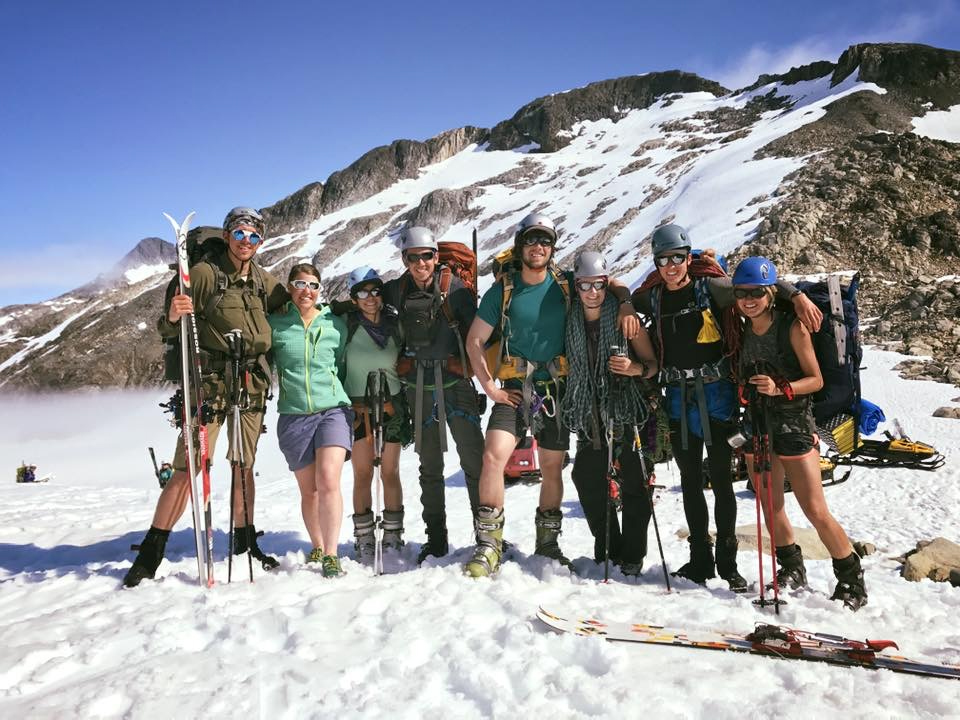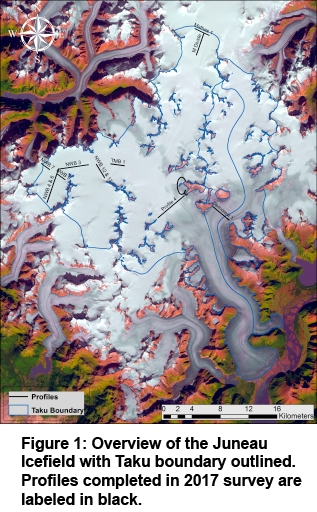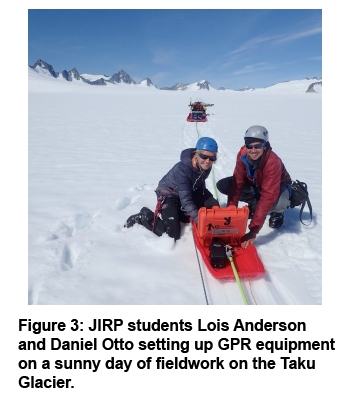
Low-Frequency GPR Measurements at Taku Glacier, Alaska
Low-Frequency GPR Measurements at Taku Glacier, Alaska
Field Team: Lynn Kaluzienski, Kiya Riverman, Lucas Beem and the following Juneau Icefield Research Program students:Brogen Kellerman, Theresa Westhaver, Daniel Otto, Avery Stewart, Amy Towell, Kyle Stewart, and Lois Anderson
June – July 2017Funding Acknowledgment: Dan & Betty Churchill Exploration Fund
Project Objectives:
The overarching goal of this project was to provide fundamental physical insights into the processes modulating the terminus position of Taku Glacier. To do so, geophysical techniques were used to determine ice thickness and basal properties of Taku Glacier and its tributaries by collecting low-frequency cross section and centerline radar profiles.
Main Achievements:
- 18 transverse and longitudinal transects of 5MHz and 10Mhz frequencies were collected along Taku Glacier and several tributary glaciers including Demorest Glacier, Matthes Glacier, and the Northwest Branch
- Post processing and analysis of the dataset found the glacial bed was visible in 5 out of 18 transects
- The maximum ice thickness measurements along a cross section of the Taku slightly exceed historical seismic measurements by Nolan et al. (1995)
- Results from the fieldwork were presented at the 2017 American Geophysical Union Conference in New Orleans, Louisiana
Fieldwork Summary:
As part of a collaborative project with Dr. Seth Campbell, Kiya Riverman (Pennsylvania State University), and Lucas Beem (University of Texas), I joined the Juneau Icefield Research Program (JIRP) as a faculty member during June-July of 2017. While at JIRP, I co-led a geophysical radar campaign on Taku Glacier with Campbell, Riverman, and Beem.
A total of 18 transects were collected along Taku Glacier and several tributary glaciers including Demorest Glacier, Matthes Glacier and the Northwest Branch (Figure 1). Due to the area’s considerable ice thickness and high water content, interference with the GPR signal only allowed the bed to be identified in five of these profiles. However, the GPR transect from Profile 4 provided a return of 1425 m. This exceeds the historical seismic measurements (1400 m) by Nolan et al. (1995) along the same profile. Future work will be completed using a higher power receiver to increase penetration and resolve bed topography at more locations across the icefield.
Collaborating with the Juneau Icefield Research Program provided a unique opportunity for 30 graduate and undergraduate participants to be trained in glaciological field research techniques using sophisticated geophysical research systems. Seven students selected to focus on GPR observations for their summer project and had an opportunity to participate in data collection, data processing, and analysis activities. In addition, JIRP funded for the students to present their fieldwork results at the 2017 American Geophysical Union Meeting in San Francisco, New Orleans.
Main Difficulties Encountered:
Challenging snow conditions were encountered throughout the field campaign. The GPR system (Blue Systems Integrated IceRadar) was designed for dry/flat snow conditions. The initial setup placed both the receiver and transmitter on skis. However, due to wet conditions the skis would repeatedly dig into the snowpack, become unstable, and tip over. To fix this problem, a make- shift setup was created using small snow sleds instead of skis.
Conference Presentations and Public Outreach based on the Fieldwork:
Amy R Towell, Anderson Lois,, Lynn M Kaluzienski, Kyle Fredrickson,, Kiya L Riverman, Brogan Kellerman, Daniel Otto, Avery Stewart, and Theresa Westhaver, Mapping Bedrock Topography of Taku Glacier with Low Frequency Ground Penetrating RADAR, Abstract C41A-1167 presented at 2017 Fall Meeting, AGU, New Orleans, Louisiana., 11- 15 Dec.
“The JIRP Blog” JUNEAU ICEFIELD RESEARCH PROGRAM, juneauicefield.com/blog/qu





